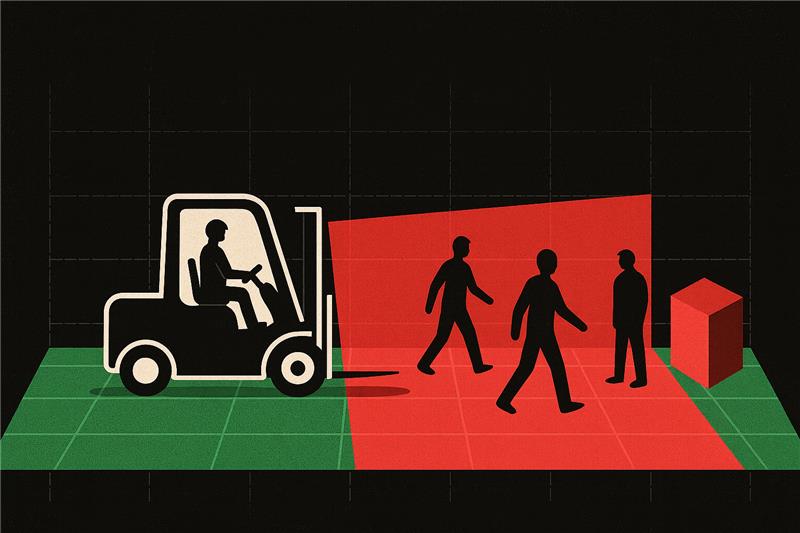Introduction
Factories are dynamic, complex, and often hazardous workplaces. Warehouses, factories, and mines are typically filled with vehicles, forklifts, and workers operating side by side in confined areas where a single lapse in judgment can result in serious accidents. Traditional safety measures like manual monitoring, warning signs, or personal protective equipment are no longer sufficient in such fast-changing environments.
That’s where advanced safety technologies come in. By incorporating computer vision, IoT sensors, and AI-driven analytics, industries can shift from reactive responses to proactive risk management predicting dangers before they occur, reducing downtime, and most importantly, saving lives.
Forklifts, in particular, remain one of the leading causes of workplace accidents. Blind spots, narrow aisles, and constant worker movement make them a high-risk factor in warehouses. AI-powered Forklift Collision Detection and Prevention Systems address these challenges by delivering 360-degree situational awareness of the vehicle’s surroundings.
These systems issue visual and audible alerts whenever a worker or object is detected nearby. In more advanced models, the system can automatically apply the brakes to prevent collisions altogether. Beyond reducing accidents, these solutions build a stronger culture of responsibility and safety. Workers gain confidence knowing they are protected, while companies benefit from fewer incidents, smoother operations, and higher levels of trust across the workforce.
Level 2 Industrial AVs and Their Influence
The evolution of automation has introduced Level 2 autonomous industrial transport vehicles, capable of accelerating, braking, and steering with minimal human intervention. These vehicles are increasingly deployed in high-traffic environments such as warehouses, ports, and logistics hubs. By continuously monitoring their surroundings, they not only improve workplace safety but also reduce reliance on human reflexes in fast-paced conditions.
Equipped with industrial motion analytics, Level 2 autonomous vehicles can analyze the movement of both workers and other vehicles, anticipate risks, and respond instantly to dangerous situations. This capability helps prevent collisions, minimizes downtime, and enhances overall operational efficiency.
The result is a safer, smarter, and more reliable workflow where machines take on the burden of real-time safety monitoring, enabling workers to focus on higher-value tasks without compromising security.
Braking Systems for Electric Industrial Trucks
With the rise of electric vehicles in industrial operations, auto-braking systems have become a critical safety feature. Powered by artificial intelligence (AI), these systems continuously monitor the vehicle’s surroundings and predict potential collisions before they occur.
Unlike traditional braking methods, AI-driven auto-braking is predictive. It reacts faster than even the most skilled human operators and can automatically engage when detecting obstacles or pedestrians in its path.
The benefits go beyond protecting workers. By preventing accidents, predictive braking reduces inventory losses, minimizes equipment damage, and lowers maintenance costs. This ensures safer operations while allowing businesses to run more efficiently with fewer unexpected disruptions.
Towards Zero Accident Warehousing
AI in industrial safety management is paving the way toward zero-accident warehouses. In these environments, safety is ensured not only by employee vigilance but also by 24/7 automated surveillance, predictive intelligence, and proactive interventions.
Artificial intelligence systems analyze traffic patterns, vehicle movements, and worker behavior to anticipate risks before they escalate into incidents. High-risk areas—such as intersections, loading bays, and storage zones—are continuously monitored to prevent accidents rather than simply respond to them.
For businesses, adopting these AI-powered systems means less operational downtime, lower insurance costs, and stronger regulatory compliance. For workers, it represents a clear commitment to their wellbeing. Over time, these investments foster a culture of risk awareness, operational discipline, and continuous safety improvement.
How Industrial Safety AI Drives Long-Term Success
The adoption of AI in industrial safety—through collision detection, predictive analytics, and autonomous vehicles—extends far beyond preventing accidents. These systems empower businesses to optimize resource allocation, streamline warehouse traffic, and make data-driven operational decisions.
With real-time pedestrian and obstacle detection, companies gain a level of situational awareness impossible to achieve through manual monitoring alone. When combined with automated interventions such as Level 2 autonomous vehicles and AI-powered auto-braking systems, the result is a comprehensive, scalable, and sustainable approach to safety.
Explore how Cognistic’s Vision AI suite, featuring IMANTRAX, enhances industrial safety and security through real-time movement tracking, hazard detection, and intelligent operational insights.
Final Thought
The future of industrial safety lies in intelligent, predictive technologies. These solutions are more than cutting-edge innovations they are life-saving advancements, from forklift collision detection to auto-braking systems and Level 2 autonomous industrial vehicles. With the integration of predictive AI systems, motion analytics, and real-time monitoring, the vision of zero-accident warehouses is closer than ever.
This transformation not only strengthens worker protection but also optimizes processes, ensures compliance, and supports sustainability. At the forefront of this evolution is Cognistic, delivering a suite of smart safety technologies that keep workers safe while maximizing performance in the most challenging industrial environments.
FAQs
- What is the mechanism by which real-time pedestrian and obstacle detection occurs?
By combining cameras, sensors, and AI, the system continuously monitors its surroundings. It can issue instant alerts and, if necessary, intervene automatically to prevent accidents. - Why are forklifts so dangerous in a warehouse?
Because they operate in tight spaces with blind spots and heavy foot traffic, the chances of accidents are high without advanced monitoring systems. - Why are UGVs with Level 2 automation a game-changer?
They reduce human error by controlling steering, acceleration, and braking, while still allowing operators to oversee safe operations. - Can existing electric industrial vehicles with auto-braking systems be retrofitted?
Yes. Many systems are modular and retrofittable, making it possible to upgrade older fleets without replacing entire vehicles. - How far are industries from achieving zero-accident warehouses?
Closer than expected. With predictive AI, real-time monitoring, and autonomous safety technologies, many warehouses are already moving toward this once-unthinkable goal.

